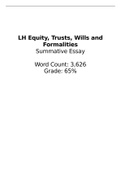LH Equity, Trusts, Wills and
Formalities
Summative Essay
Word Count: 3,626
Grade: 65%
, In Stack v Dowden [2007] UKHL 17, Lord Neuberger favoured the
‘resulting trust solution’. In light of the problematic ways in which
common intention constructive trusts law has developed, Lord Neuberger’s
approach would, at least, have produced consistency and certainty in the
law. With reference to relevant law and academic opinion, to what extent
do you agree with this statement?
1 Introduction
Regardless of the somewhat problematic way in which common intention constructive trusts
(CICT) law has developed in the domestic context, I do not agree with Lord Neuberger’s
approach that the resulting trust (RT) solution would have produced more consistency and
certainty in the law if adopted by the House of Lords post Stack v Dowden1. I argue this
because in order for certainty and consistency in common law, the legislation must be
appropriate in its application to the cases. I do not believe the RT has effectively adapted to
the socio-economic changes that have occurred in the UK in the past decades. This problem
is reflected in Stack where two separating cohabitants lacked an express declaration of a trust,
therefore requiring the court to determine whether the beneficial interest in the property was a
RT or a CICT. The Baroness Hale representing the majority decision held that “in the
absence of an express agreement, courts may take into account not only financial factors but,
inter alia, the purpose of acquiring the home, the nature of the parties’ relationship, and their
personalities, in deciding the issue by a CICT.”2 Lord Neuberger dissented in favour of the
traditional RT solution, arguing “in the absence of statutory provisions to the contrary, the
same principles should apply to assess the apportionment of the beneficial interest as between
legal co-owners, whether in a sexual, platonic, familial, amicable or commercial
relationship”3. Applying relevant law and academic commentary, I will now assess the
crucial benefits in the development and implementation of the CICT approach by the court
and will evaluate its advantages over the RT approach.
1
[2007] UKHL 17
2
Yee Ching Leung, 'Rethinking The Common Intention Constructive Trusts In Stack V Dowden And Jones V
Kernott – Should The Resulting Trusts Be Preferred?' (2019) 6 IALS Student Law Review.
3
Stack v Dowden [2007] UKHL 17, at [107]




